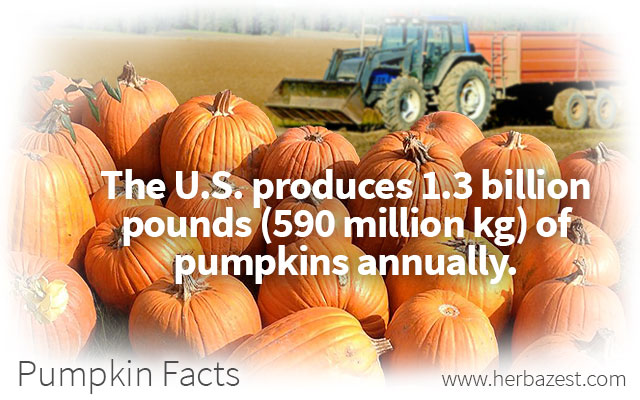Did you know that pumpkins were once considered to be a cure for freckles, or that their flesh has been used as a skin treatment for burns? Keep reading to discover even more about this delicious herb with these cool facts about pumpkins.
- Botanically speaking, pumpkin is considered to be a fruit. This is because it has seeds and develops from the mature ovary of pumpkin blossoms.
- Pumpkins are the round, orange squashes that are commonly used for pies and jack-o-lanterns. The term pumpkin places the emphasis on the color and shape of the fruit, and not necessarily its botanical makeup. Therefore, it can be said that all pumpkins are squashes, but not all squashes are pumpkins.
- Some pumpkins may also be considered gourds, which are robust, hard-shelled fruits, harvested primarily for their decorative and ornamental use.
- The pumpkin is believed to be native to the Americas, though its exact origin has not been confirmed.
- The earliest known archeological evidences of pumpkin cultivation were found in Mexico, in the Oaxaca valley and the caves of Ocampo, Tamaulipas; they may date as far back as 8750 BCE and 7000 BCE, respectively.
- Pumpkins, squashes, and gourds all belong to a very large botanical group called the Cucurbitaceae family. They are classified into hundreds of different species according to their leaves, vines, size, and general appearance. The common field pumpkin is known by the scientific name Cucurbita pepo.
- Pumpkins are typically bright orange, but because many cultivars exist, other color variations are possible. A typical pumpkin is about 20 - 40 pounds (9 - 18 kg), though the common field pumpkin can grow up to 65 pounds (29 kg).
- Pumpkins have rampantly-growing vines that need a lot of room to breathe and spread out as the plant grows. Pumpkin plants should be planted near the end of spring, as they crave warm soil, and seeds will not germinate in cold temperatures. The fruit can be harvested in 18 - 24 weeks.
- Propagation of the pumpkin plant generally occurs when bees transfer pollen from the male flowers to the female flowers. However, it can also be accomplished through human intervention by hand-pollinating the pistil of a female flower.
- The pumpkin's flesh can be either sweet or bitter, and it is commonly used in pies, scones, soups, stews, and other recipes.
- Pumpkins are high in protein and fiber, but low in fat. They are an excellent source of iron and vitamin A.
- Cooked pumpkin provides about 20 calories and 4.90 g of carbohydrates per 100 g serving.
- Pumpkins possess abundant vitamins and nutrients, which support its anti-inflammatory, antioxidant, and antifungal properties.
- Pumpkin flower blossoms have a light, buttery taste. They are sometimes prepared as vegetables in a number of pasta, soup, and salad recipes.
- Pumpkin leaves are also edible. They are chock-full of iron, and may be prepared like other dark green, leafy vegetables.
- Pumpkin seeds are usually roasted and consumed as healthy, protein-packed snacks.
- The U.S. produces 1.3 billion pounds (590 million kg) of pumpkins annually.
- China is the leading producer of pumpkins and squashes, with an estimated seven million tons produced each year.
- The young fruit of a pumpkin is best used in savory entrees and sides, while the mature fruit goes best in pies and other sweet desserts. Medium-sized varieties, like 'Autumn Gold', 'Jack-o-Lantern', and 'Spirit' are among the best for culinary use; however, larger varieties like 'Big Tom' and 'Jackpot' are also popular.
- The biggest pumpkin ever grown was 2,323 pounds (1,054 kg)!
Sources
- European Food Research & Technology, Variability of vitamin E content in pumpkin seeds (Cucurbita pepo L), 1996
- International Journal of Food Science and Technology, Vitamins composition of pulp, seed and rind of fresh and dry Rambutan Nephelium Lappaceum and squash Cucurbita pepo L, 2013
- Missouri Botanical Garden, Gardening Help FAQs, Horticulture Questions and Answers
- National Institutes of Health, Office of Dietary Supplements, Vitamin A
- Purdue University, Squash, pumpkins & gourds | Cucurbits
- University of California, Vegetable Research & Information Center
- University of Illinois, Extension Office, Pumpkins and More
- USDA Nutrient Database
- Power Foods, pp. 25, 57, 358, 371




